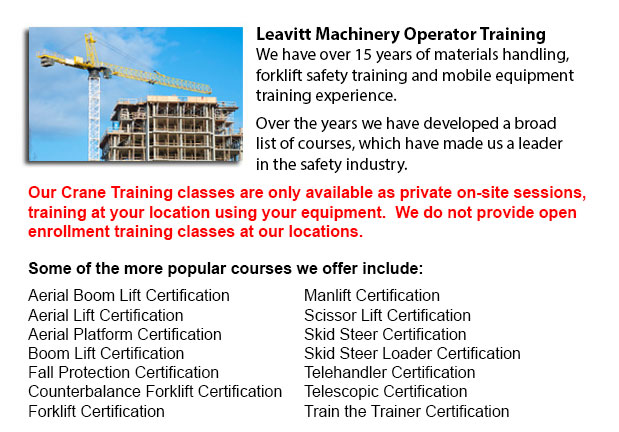
London Crane Certification - The Crane Certification training program covers subject matter suggested by industry about the safe and efficient operation of cranes. People training will know the following: pre-operational, operational and post operating requirements; how to identify cranes and their component parts; rigging components and inspection/rejection criteria; how to determine overall lift capacity; and needs specific to the work location where the people training would be operating.
The requirements which should be performed before operating a crane such as assigning authority for the pre-operational check; performing the sequential pre-operational check based on the manufacturer's specifications or specifications certified by a professional engineer; checking the log book for comments; inspecting the work place for hazards and obstacles; checking hooks, chains, cables, safety latches and crane movement; making certain of the proper functioning of operational controls; and knowing how to make sure that the disconnect switch/isolator of the crane is functioning right.
The requirements to operating a crane will include the identifying of roles and responsibilities, and the determination of the requirement for a formal lift plan. The trainee will know how to do hazard assessments for the varying environmental situations, physical conditions and workers. Subject matter consists of determining when to seek competent help, the destination of loads and the safest route, and centre of gravity and load weight.
It is vital for individuals training to be able to identify an over-capacity lift, pick correct rigging machinery, be aware of load limits, and determine a safe site from which to work. Trainees would review both site-specific and universal crane signals for lifts, and methods for loading, traveling and lifting. Right maintenance practice will be included.
People training would be assessed on their understanding of the need for emergency response procedures for different conditions like for instance a mechanical or electrical failure. They would be asked to describe parking and shut down procedures for security and safety, to follow lock out and tagging procedures, and to explain the reason why near misses are reported and recorded to the right individual. Log book records should be maintained.
Individuals training would develop knowledge of rigging, particularly, establishing who has responsibility and authority for rigging, identifying various types of rigging, knowing storage procedures and load capacity ratings.
Post-operational requirements include entering deficiencies or defects, service and maintenance history in the log book, based on Federal, state and provincial codes requirements.
Site-specific needs could be included into the safety training program based on the employer's needs.
-
London Crane License
London Crane License - Crane operators ought to be "credentialed", that means they must possess a crane operator license or certification. Credentialing is considered a mandatory governmental requirement in order to practice as a crane operator. Obta... More -
London Heavy Equipment Operator Training
London Heavy Equipment Operator Training - Training facilities which offer quality standards in the industry and not just provide field performing tasks but added equipment training are highly sought after. Accredited schools provide students the kno... More -
Telehandler Training in London
Telescopic handlers usually referred to as telehandlers for short, are a very popular piece of heavy construction machinery. They are usually utilized in the agriculture and construction industries. These machines have maximum reaching capacity and c... More -
London Boom Lift Certification
London Boom Lift Certification - Elevated work platforms allow maintenance operations and work to be carried out at heights which could not be reached by any other means. Workers utilizing boom lifts and scissor lifts can learn how to safely operate... More -
London Fall Protection Ticket
London Fall Protection Ticket - Fall-related accidents are the number one reason of death within the construction industry. The potential for fall incidents really increases based upon the kind of work that is being completed within your workplace. T... More -
London Forklift Safety Training
London Forklift Safety Training - Anybody who wants to operate a lift truck should take a forklift safety training program to become a certified forklift truck operator. There are several ways to obtain forklift training. Programs are provided throug... More -
Operator Safety Training, Re-Qualification Training, In-House Instructor Training in London
Lift trucks are used in nearly all warehouse operations and in boat yards and in industrial construction sites. The reach feature of a forklift is a vital component used in various applications like for instance whenever a shelving system is being us... More -
London Boom Lift Safety Training
London Boom Lift Safey Training - Boom lifts are a type of elevated work platform or aerial lifting device that are commonly utilized in construction, industry, and warehousing. Boom lifts can be used in practically any surroundings due to their vers... More

Forklift Certification London
TOLL FREE: 1-888-254-6157
London, Ontario
forkliftcertificationlondon.com
Email Us
About Us


